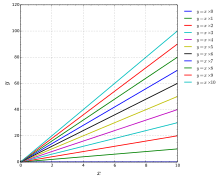Multiplication
Multiplication
The multiplication of whole numbers may be thought as a repeated addition; that is, the multiplication of two numbers is equivalent to adding as many copies of one of them, the multiplicand, as the value of the other one, the multiplier. Normally, the multiplier is written first and multiplicand second (though this can vary by language).
For example, 4 multiplied by 3 (often written as and spoken as "3 times 4") can be calculated by adding 3 copies of 4 together:
Here 3 and 4 are the "factors" and 12 is the "product".
One of the main properties of multiplication is the commutative property: adding 3 copies of 4 gives the same result as adding 4 copies of 3:
Thus the designation of multiplier and multiplicand does not affect the result of the multiplication.
The multiplication of integers (including negative numbers), rational numbers (fractions) and real numbers is defined by a systematic generalization of this basic definition.
Video: How to easily memorize the multiplication tables
Multiplication can also be visualized as counting objects arranged in a rectangle (for whole numbers) or as finding the area of a rectangle whose sides have given lengths. The area of a rectangle does not depend on which side is measured first, which illustrates the commutative property. The product of two measurements is a new type of measurement, for instance multiplying the lengths of the two sides of a rectangle gives its area, this is the subject of dimensional analysis.
The inverse operation of multiplication is division. For example, since 4 multiplied by 3 equals 12, then 12 divided by 3 equals 4. Multiplication by 3, followed by division by 3, yields the original number (since the division of a number other than 0 by itself equals 1).
Multiplication is also defined for other types of numbers, such as complex numbers, and more abstract constructs, like matrices. For these more abstract constructs, the order that the operands are multiplied sometimes does matter.
Properties
Figure: Multiplication of numbers 0–10. Line labels = multiplicand. X axis = multiplier. Y axis = product.
Extension of this pattern into other quadrants gives the reason why a negative number times a negative number yields a positive number.
For the real and complex numbers, which includes for example natural numbers, integers and fractions, multiplication has certain properties:
-
Commutative property
- The order in which two numbers are multiplied does not matter
-
-
Video: Commutative law of multiplication
-
Associative property
- Expressions solely involving multiplication or addition are invariant with respect to order of operations:
-
-
Video: Associative property of multiplication
------
‹ Subtraction video up Multiplication videos ›


 and spoken as "3 times 4") can be calculated by adding 3 copies of 4 together:
and spoken as "3 times 4") can be calculated by adding 3 copies of 4 together:





